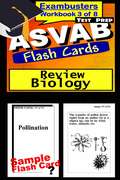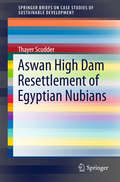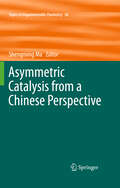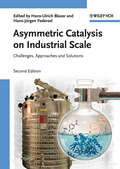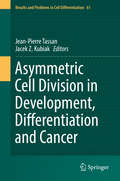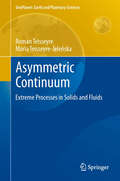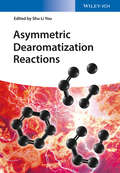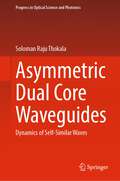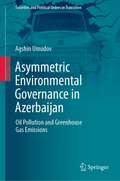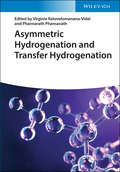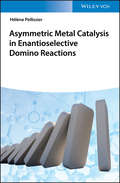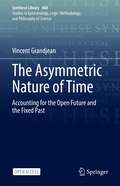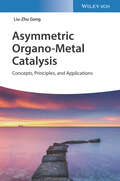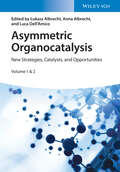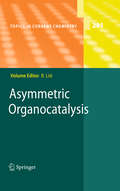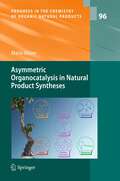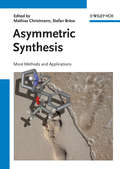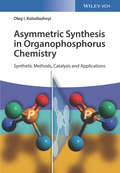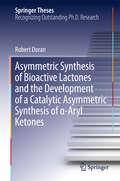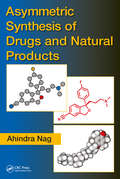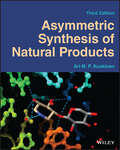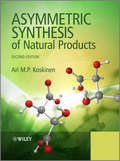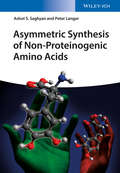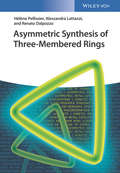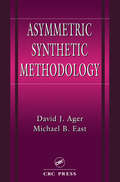- Table View
- List View
ASVAB Test Prep Flash Cards: Biology (Exambusters ASVAB Workbook #3 of 8)
by Ace Inc.<P><P><i>Advisory: Bookshare has learned that this book offers only partial accessibility. We have kept it in the collection because it is useful for some of our members. Benetech is actively working on projects to improve accessibility issues such as these.</i><P><P> 450 questions and answers.<P><P> Topics: Cells, Biochemistry and Energy, Evolution, Kingdoms: Monera, Fungi, Protista, Plants, Animals; Human: Locomotion, Circulation, Immunology, Respiration, Excretion, Digestion, Nervous System <P>EXAMBUSTERS ASVAB Prep Workbooks provide comprehensive, fundamental ASVAB review--one fact at a time--to prepare students to take practice ASVAB tests. Each ASVAB study guide focuses on one specific subject area covered on the ASVAB exam. From 300 to 600 questions and answers, each volume in the ASVAB series is a quick and easy, focused read. Reviewing ASVAB flash cards is the first step toward more confident ASVAB preparation and ultimately, higher ASVAB exam scores!
Aswan High Dam Resettlement of Egyptian Nubians (SpringerBriefs on Case Studies of Sustainable Development)
by Thayer ScudderThis book highlights the long-term resettlement process of the Egyptian Nubian people along the Aswan High Dam. Assessing the resettlement of 48,000 Egyptian Nubians in connection with the High Dam is especially important for three main reasons: firstly, this resettlement process is one of the rare cases in which research begun before the dam was built has continued for over forty years. Secondly, the resettlement of the Egyptian Nubian people is one of the few cases in which the living standards of the large majority improved because of the initial political will of the government, combined with Nubian initiatives. Thirdly, given the complexity of the resettlement process, weaknesses in government planning, implementation, and in the weakening of government political provide valuable lessons for future dam-induced resettlement efforts.
Asymmetric Catalysis from a Chinese Perspective (Topics in Organometallic Chemistry #36)
by Shengming MaQi-Lin Zhou and Jian-Hua Xie: Chiral Spiro Catalysts.- Fuk Loi Lam, Fuk Yee Kwong and Albert S. C. Chan: Chiral Phosphorus Ligands with Interesting Properties and Practical Applications.- Jiang Pan, Hui-Lei Yu, Jian-He Xu, Guo-Qiang Lin: Advances in Biocatalysis: Enzymatic Reactions and Their Applications.- Mei-Xiang Wang: Enantioselective Biotransformations of Nitriles.- Man Kin Wong, Yiu Chung Yip and Dan Yang: Asymmetric Epoxidation Catalyzed by Chiral Ketones.- W. J. Liu, N. Li and L. Z. Gong: Asymmetric Organocatalysis.- Qing-Hua Fan and Kuiling Ding: Enantioselective Catalysis with Structurally Tunable Immobilized Catalysts.- Chang-Hua Ding, Xue-Long Hou: Transition Metal-Catalyzed Asymmetric Allylation.- Jian Zhou and Yong Tang: Enantioselective Reactions with Trisoxazolines.- Xiang-Ping Hu, Duo-Sheng Wang, Chang-Bin Yu, Yong-Gui Zhou, and Zhuo Zheng: Adventure in Asymmetric Hydrogenation: Synthesis of Chiral Phosphorus Ligands and Asymmetric Hydrogenation of Heteroaromtics.
Asymmetric Catalysis on Industrial Scale: Challenges, Approaches and Solutions
by Hans-Ulrich Blaser et al.This second edition of the pioneering work on this hot topic captures the major trends and latest achievements in the art of asymmetric catalysis on an industrial scale. A number of completely new real-life case studies written by the world leaders in their respective areas provide a compact and qualified insight into this developing field. The resulting ready reference and handbook collates first-hand and valuable information within a context where it can be easily found. The high-quality contributions illustrate the relevant environments and situations, such as time pressure, how the catalytic step fits into the overall synthesis, or competition with other synthetic approaches, as well as the typical problems encountered in the various phases, including finding/developing the catalyst and optimization of the process or choice of equipment. Both successful and unsuccessful approaches to solve these problems are described.
Asymmetric Cell Division in Development, Differentiation and Cancer (Results and Problems in Cell Differentiation #61)
by Jacek Z. Kubiak Jean-Pierre TassanThis book provides readers with an overview of the frequent occurrence of asymmetric cell division. Employing a broad range of examples, it highlights how this mode of cell division constitutes the basis of multicellular organism development and how its misregulation can lead to cancer. To underline such developmental correlations, readers will for example gain insights into stem cell fate and tumor growth. In turn, subsequent chapters include descriptions of asymmetric cell division from unicellular organisms to humans in both physiological and pathological conditions. The book also illustrates the importance of this process for evolution and our need to understand the background mechanisms, offering a valuable guide not only for students in the field of developmental biology but also for experienced researchers from neighboring fields.
Asymmetric Continuum: Extreme Processes in Solids and Fluids (GeoPlanet: Earth and Planetary Sciences #3)
by Roman Teisseyre Maria Teisseyre-JeleńskaThis book deals with a class of basic deformations in Asymmetric Continuum Theory. It describes molecular deformations and transport velocities in fluids, strain deformations in solids as well as the molecular transport, important in fracture processes. In solids, a separate problem relates to the displacements; their recording, e. g. , by means of the seismometers, proves only the existence of the displacement derivatives and not a real displacement. However, the molecular displacements and new fracture criterion including the defect distributions and induced strains are defined in the book too. In fluids, the transport velocities and molecular strains describe the motion processes. The vortex motions are defined by means of the rotational transport; this approach leads to more complicated problems, like the turbulence phenomena. The interaction processes, including the electric and magnetic fields, and some thermodynamical problems and quantum theory analogies help to understand the extreme processes
Asymmetric Dearomatization Reactions
by Shu-Li YouThe first comprehensive account of the rapidly growing field of asymmetric dearomatization reactions with a focus on catalytic methods. It introduces the concept of dearomatization and describes recent progress in asymmetric reaction procedures with different catalyst systems, such as organocatalysts, transition metal catalysts, and enzymes. Chapters on dearomatizations of electron-deficient aromatic rings, dearomatization reactions via transition metal-catalyzed cross-couplings as well as dearomatization strategies in the synthesis of complex natural products are also included. Written by pioneers in the field, this is a highly valuable source of information not only for professional synthetic chemists in academia and industry but also for all those are interested in asymmetric methodologies and organic synthesis in general.
Asymmetric Dual Core Waveguides: Dynamics of Self-Similar Waves (Progress in Optical Science and Photonics #22)
by Soloman Raju ThokalaThis book highlights the dynamical behavior of self-similar waves in asymmetric dual-core waveguides. The proposed dual-core waveguide consists of two closely spaced adjoining fibers in which one fiber is active and the other is passive. Due to the linear coupling between them, the dynamics of the wave propagating through the passive core can be controlled by manipulating the dynamics of the wave propagating in the active core. The optimal pulse compression or amplification of these waves as the length of the fiber tends to infinity is presented. The exact Mobius transform self-similar solutions that propagate through these waveguides self-similarly are subject to simple scaling rules. The book includes experiments conducted to corroborate the analytical predictions.
Asymmetric Environmental Governance in Azerbaijan: Oil Pollution and Greenhouse Gas Emissions (Societies and Political Orders in Transition)
by Agshin UmudovThis book examines why authoritarian governments are willing to address environmental problems that have an international impact, such as CO2 emissions, but are reluctant to address problems that have only a domestic impact. In a case study of Azerbaijani oil politics, it demonstrates how the incumbent Azerbaijani regime has taken important measures trying to address CO2 emissions while ignoring the damage caused by oil pollution on the Caspian coast. The book argues that resource-rich authoritarian governments are eager to join international environmental initiatives to improve their image, but they address domestic environmental issues mainly if they threaten their hold on power.This book is an important contribution to scholarship on environmental governance in the post-Soviet space, an area that is poorly researched. Therefore, it is a must-read for researchers and scholars interested in post-Soviet studies, as well as in the nexus between mineral-rich regions and how social policy is created, e.g., environment, education, and healthcare. In addition, this book will be of tremendous importance for policymakers and international organizations as it looks into the motivation of authoritarian states in the post-Soviet space for environmental measures.
Asymmetric Hydrogenation and Transfer Hydrogenation
by Virginie Ratovelomanana-VidalDiscover the latest developments in homogeneous asymmetric (transfer) hydrogenation with this up-to-date resource Asymmetric Hydrogenation and Transfer Hydrogenation delivers a current and cutting-edge investigation of homogenous asymmetric hydrogenation and transfer hydrogenation reactions of prochiral substrates by using organometallic catalysts (like ruthenium, rhodium, iridium, iron, and copper) and organic catalysts. Distinguished researchers and editors Virginie Ratovelomanana-Vidal and Phannarath Phansavath also offer readers a comprehensive walkthrough of substituted ketones through dynamic kinetic resolution, as well a presentation of the mechanisms and application of asymmetric hydrogenation reactions to the synthesis of biologically relevant compounds. The book comprehensively details its complex subject matter clearly and plainly and covers everything from catalyst development and reactions to mechanisms and applications in academia and industry. The papers included within come from many of the leading voices in their respective fields and represent the newest and best research available today. Compiled for researchers and private-industry chemists alike, Asymmetric Hydrogenation and Transfer Hydrogenation also discusses a wide variety of other topics like: A discussion of the development of chiral metal catalysts for asymmetric transfer hydrogenation Several examinations of asymmetric transfer hydrogenation of a variety of chemical groups, including ketones, aryl and heteroaryl ketones, substituted ketones, and heteroaromatic compounds, akenes, and imines An exploration of the mechanism of asymmetric hydrogenation and continuous flow asymmetric hydrogenation A full and thorough treatment of the industrial applications of asymmetric hydrogenation Perfect for catalytic chemists, chemists working on or with organometallics, organic chemists, natural product chemists, pharmaceutical chemists, medicinal chemists, and industrial chemists, Asymmetric Hydrogenation and Transfer Hydrogenation also belongs on the bookshelves of research and university institutes and libraries who wish to expand their selection on a topic fundamental to organic synthesis.
Asymmetric Metal Catalysis in Enantioselective Domino Reactions
by Helene PellissierIntroduces an innovative and outstanding tool for the easy synthesis of complex chiral structures in a single step Covering all of the literature since the beginning of 2006, this must-have book for chemists collects the major progress in the field of enantioselective one-, two-, and multicomponent domino reactions promoted by chiral metal catalysts. It clearly illustrates how enantioselective metal-catalyzed processes constitute outstanding tools for the development of a wide variety of fascinating one-pot asymmetric domino reactions, thereby allowing many complex products to be easily generated from simple materials in one step. The book also strictly follows the definition of domino reactions by Tietze as single-, two-, as well as multicomponent transformations. Asymmetric Metal Catalysis in Enantioselective Domino Reactions is divided into twelve chapters, dealing with enantioselective copper-, palladium-, rhodium-, scandium-, silver-, nickel-, gold-, magnesium-, cobalt-, zinc-, yttrium and ytterbium-, and other metal-catalyzed domino reactions. Most of the chapters are divided into two parts dealing successively with one- and two-component domino reactions, and three-component processes. Each part is subdivided according to the nature of domino reactions. Each chapter of the book includes selected applications of synthetic methodologies to prepare natural and biologically active products. -Presents the novel combination of asymmetric metal catalysis with the concept of fascinating domino reactions, which allows high molecular complexity with a remarkable level of enantioselectivity -Showcases an incredible tool synthesizing complex and diverse chiral structures in a single reaction step -Includes applications in total synthesis of natural products and biologically active compounds -Written by a renowned international specialist in the field -Stimulates the design of novel asymmetric domino reactions and their use in the synthesis of natural products, pharmaceuticals, agrochemicals, and materials Asymmetric Metal Catalysis in Enantioselective Domino Reactions will be of high interest to synthetic, organic, medicinal, and catalytic chemists in academia and R&D departments.
The Asymmetric Nature of Time: Accounting for the Open Future and the Fixed Past (Synthese Library #468)
by Vincent GrandjeanThis open access monograph offers a detailed study and a systematic defense of a key intuition we typically have, as human beings, with respect to the nature of time: the intuition that the future is open, whereas the past is fixed. For example, whereas it seems unsettled whether there will be a fourth world war, it is settled that there was a first world war.The book contributes, in particular, three major and original insights. First, it provides a coherent, non-metaphorical, and metaphysically illuminating elucidation of the intuition. Second, it determines which model of the temporal structure of the world is most appropriate to accommodate the intuition, and settles on a specific version of the Growing Block Theory of time (GBT). Third, it puts forward a naturalistic foundation for GBT, by exploiting recent results of our best physics (viz. General Relativity, Quantum Mechanics, and Quantum Gravity). Three main challenges are addressed: the dismissal of temporal asymmetries as non-fundamental phenomena only (e.g., thermodynamic or causal phenomena), the epistemic objection against GBT, and the apparent tension between GBT and relativistic physics. It is argued that the asymmetry between the open future and the fixed past must be grounded in the temporal structure of the world, and that this is neither precluded by our epistemic device, nor by the latest approaches to Quantum Gravity (e.g., the Causal Set Theory). Aiming at reconciling time as we find it in ordinary experience and time as physics describes it, this innovative book will raise the interest of both academic researchers and graduate students working on the philosophy of time. More generally, it presents contents of interest for all metaphysicians and non-dogmatic philosophers of physics.This is an open access book.
Asymmetric Organo-Metal Catalysis: Concepts, Principles, and Applications
by Liu-Zhu GongExplore the latest advances involving organo/metal combined catalysts from leading contributors in the field In Asymmetric Organo-Metal Catalysis: Concepts, Principles, and Applications, accomplished chemist Liu-Zhu Gong delivers a comprehensive discussion of how to design efficient organo/metal combined catalyst systems, new cooperatively catalyzed asymmetric reactions, relay catalytic cascades, and multicomponent reactions. The distinguished author covers critical topics, like the combined catalysis of chiral phase transfer catalysts, enamine, iminium, nucleophilic Lewis base, or Bronsted acids with metal complexes, while also covering the cooperative catalysis of photocatalysts and organocatalysts. The book offers readers an exploration of the general concepts and principles of bond activation and reorganization, together with a comprehensive introduction to the historical developments and recent advances in the field. Readers will also benefit from the descriptions of new chemistry and new synthetic methods included within. Asymmetric Organo-Metal Catalysis also provides: Thorough introductions to chiral PTC-metal cooperative catalysis and enamine-metal cooperative catalysis Comprehensive explorations of iminum-metal relay catalysis and cooperative catalysis of bronsted acids and transition metals Practical discussions of metal-bronsted acid relay catalysis and Lewis base–Lewis acid cooperative catalysis In-depth examinations of Lewis base-transition metal cooperative catalysis and photocatalysis combined with organocatalysis Perfect for organic, catalytic, and pharmaceutical chemists, Asymmetric Organo-Metal Catalysis: Concepts, Principles, and Applications is also an invaluable resource for chemists working with or on organometallics.
Asymmetric Organocatalysis: New Strategies, Catalysts, and Opportunities, 2 Volumes
by Lukasz AlbrechtAsymmetric Organocatalysis Comprehensive resource on the latest and most important developments in the highly vivid field of asymmetric organocatalysis The book provides a comprehensive overview of the most important advancements in the field of asymmetric organocatalysis that have occurred within the last decade. It presents valuable examples of newly developed synthetic methodologies based on various organocatalytic activation modes. Special emphasis is given to strategies where organocatalysis is expanding its potential by pushing the boundaries and founding new synergistic interactions with other fields of synthetic chemistry, such as metal catalysis, photocatalysis, and biocatalysis. The application of different concepts (such as vinylogy, dearomatization, or cascade reactivity), resulting in the development of new functionalization strategies, is also discussed. Sample topics covered within the book include: New developments in enantioselective Brønsted acid catalysis with strong hydrogen-bond donors Asymmetric phase-transfer catalysis, from classical applications to new concepts Halogen-bonding organocatalysis Asymmetric electrochemical organocatalysis and synergistic organo-organocatalysis Immobilized organocatalysts for enantioselective continuous flow processes Mechanochemistry and high-pressure techniques in asymmetric organocatalysis Useful tools in elucidation of organocatalytic reaction mechanisms With an overall focus on new reactions and catalysts, this two-volume work is an indispensable source for everyone working in the field of asymmetric organocatalysis.
Asymmetric Organocatalysis: Lewis Base And Acid Catalysts (Topics in Current Chemistry #291)
by Benjamin ListKerstin Etzenbach-Effers, Albrecht Berkessel: Non-Covalent Organocatalysis Based on Hydrogen Bonding: Elucidation of Reaction Paths by Computational Methods. - Petri M. Pihko, Inkeri Majander, and Anniina Erkkilä: Enamine Catalysis. - Jennifer L. Moore, Tomislav Rovis: Lewis Base Catalysts 6: Carbene Catalysts. - Amal Ting, Jennifer M. Goss, Nolan T. McDougal, and Scott E. Schaus: Brønsted Base Catalysts. - O. Andrea Wong, Yian Shi: Chiral Ketone and Iminium Catalysts for Olefin Epoxidation. - Alan C. Spivey, Stellios Arseniyadis: Amine, Alcohol and Phosphine Catalysts for Acyl Transfer Reactions. - John B. Brazier, Nicholas C. O. Tomkinson: Lewis Base Catalysts 2 Secondary and Primary Amine Catalysts for Iminium Catalysis. - Oksana Sereda, Sobia Tabassum, and René Wilhelm: Lewis Acid Organocatalysts. - Daniela Kampen, Corinna M. Reisinger, and Benjamin List: Chiral Bronsted Acids for C Organocatalysis.
Asymmetric Organocatalysis in Natural Product Syntheses (Progress in the Chemistry of Organic Natural Products #96)
by Mario WaserThis book provides the reader with an illustrative overview concerning successful and widely used applications of organocatalysis in the field of natural product synthesis. The main focus will be on organocatalytic key-steps for each (multi-step) synthesis described, whereas other often particularly innovative transformations will be omitted, as this would be beyond the scope of this volume.
Asymmetric Synthesis II
by Mathias Christmann Stefan BräseAfter the overwhelming success of 'Asymmetric Synthesis - The Essentials', narrating the colorful history of asymmetric synthesis, thisis the second edition with latest subjects and authors. While the aim of the first edition was mainly to honor the achievements of the pioneersin asymmetric syntheses, the aim of this new edition was bringing the current developments, especially from younger colleagues, to theattention of students. The format of the book remained unchanged, i.e. short conceptual overviews by young leaders in their field includinga short biography of the authors. The growing multidisciplinary research within chemistry is reflected in the selection of topics including metal catalysis, organocatalysis, physical organic chemistry, analytical chemistry, and its applications in total synthesis. The prospective reader of this book is a graduate or undergraduate student of advanced organic chemistry as well as the industrial chemist who wants to get a brief update on the current developments in the field.
Asymmetric Synthesis in Organophosphorus Chemistry: Synthetic Methods, Catalysis and Applications
by Oleg I. KolodiazhnyiAuthored by one of the leading experts in the field, this is the only comprehensive overview of chiral organophosphorus compounds, from asymmetric synthesis to catalysis and pharmacological applications. As such, this unique reference covers the chemical background as well as spectroscopical analysis of phosphorus compounds, and thoroughly describes all the various synthetic strategies for these substances. Metal-, organo- and biocatalyzed reactions for the introduction of phosphorus are explained as are asymmetric oxidation and reduction methods for the preparation of all possible oxidation states of phosphorus. The text also includes industrial applications for these compounds. Of particular interest to chemists working in the field of asymmetric synthesis, as well as to the pharmaceutical industry due to the increasing number of phosphorous-containing drugs.
Asymmetric Synthesis of Bioactive Lactones and the Development of a Catalytic Asymmetric Synthesis of α-Aryl Ketones (Springer Theses)
by Robert DoranThis thesis addresses two fundamental areas in contemporary organic chemistry: synthesis of natural products and catalytic asymmetric synthesis. Firstly, a new methodology, developed by our research group, which allows the asymmetric synthesis of lactones, a structural unit ubiquitous in natural products, was utilised in the synthesis of a number of natural product analogues that showed significant biological activity. Secondly, the development of a catalytic asymmetric synthesis of a key structural motif present in a number of natural products and pharmaceuticals was accomplished. During the course of this work we discovered dual stereo control, which is significant because it allows the configuration of a new stereo centre to be controlled by a simple change of proton source.
Asymmetric Synthesis of Drugs and Natural Products
by Ahindra NagThis book focuses on different techniques of asymmetric synthesis of important compounds, such as drugs and natural products. It gives insightful information on recent asymmetric synthesis by Inorganic, Organic and Enzymatic combinations. It also emphasizes chiral compounds and design of new catalyst for synthesis of compounds.
Asymmetric Synthesis of Natural Products
by Ari M. KoskinenAsymmetric Synthesis of Natural Products Fully updated learning resource covering the concept of using natural product chemistry for strategies in asymmetric synthesis The third edition of Asymmetric Synthesis of Natural Products introduces students to the rapidly growing field of natural products in organic chemistry, discussing the practical, mainly pharmacological, importance of selected compounds and emphasizing the target-oriented approach of organic synthesis which is key in industrial strategies. To aid in reader comprehension, the text includes key references and an Index of Compounds. The textbook is based on two lecture courses (Asymmetric Synthesis & Asymmetric Synthesis of Natural Products), which the author has delivered more than 50 times over the past 20 years in Finland, the UK, Italy, and Greece. This third edition is fully updated from the earlier versions (published by Wiley in 1993 and 2012). The importance of natural products as truly renewable raw materials in sustainable chemistry and circular economy is illustrated through applications of e.g. organocatalysis, organometallic catalysis, and biocatalysis. The contents consist of traditional text supplemented with illustrations (such as chemical drawings and structural formulae). Three dimensional aspects are also discussed with the use of 3D renderings of structures for both reaction mechanisms (molecular modeling) and crystallographic data. Sample topics covered in the textbook include: The foundations of asymmetric synthesis, including the theory and applications of individual asymmetric reactions Sustainable development, the circular economy, and use of renewable raw materials that have become prominent in many fields of science and technology Various natural product classes, including carbohydrates, amino acids, peptides, proteins, nucleosides, nucleotides, nucleic acids, and polyketides The properties of these natural product classes, including their structures, biosynthesis, and interrelationships, as well as examples of asymmetric syntheses and the practical value of these compounds Asymmetric Synthesis of Natural Products is a comprehensive, authoritative, and up-to-date learning resource on the subject for advanced level undergraduate or early-stage graduate students. It is also useful for specialists already working in synthesis who wish to learn about asymmetric synthesis.
Asymmetric Synthesis of Natural Products
by Ari M. KoskinenAsymmetric Synthesis of Natural Products, 2nd Edition introduces students to this rapidly growing field of organic chemistry. The initial chapters present the foundations of asymmetric synthesis, including the theory and applications of individual asymmetric reactions. This is followed by chapters on each of the major individual classes of natural products; their structures, biosynthesis and interrelationships as well as examples of asymmetric syntheses and the practical value of these compounds. Natural product classes covered include carbohydrates, amino acids, peptides, proteins, nucleosides, nucleotides, nucleic acids, polyketides, isoprenoids, shikamic acid derivatives and alkaloids.For this second edition the text has been thoroughly updated and expanded, and includes new discussions and examples covering atom and redox economies, practical aspects and environmental awareness. Organocatalysis has emerged completely in the last ten years, and has been fully integrated into this new edition.
Asymmetric Synthesis of Non-Proteinogenic Amino Acids
by Peter Langer Ashot S. SaghyanAuthored by two internationally recognized experts with an excellent track record, this much-needed reference summarizes latest research in the rapidly developing field of stereoselective synthesis of enantiomerically enriched amino acids, particularly of non-proteinogenic origin. It highlights several different catalytic and stoichiometric asymmetric methods for their synthesis and also provides information on origin, biological properties, different synthetic strategies and important applications in medicine and pharmacology. Essential reading for synthetic chemists working in the field of asymmetric synthesis, natural products and peptide synthesis, stereochemistry, medicinal chemistry, biochemistry, pharmacology, and biotechnology.
Asymmetric Synthesis of Three-Membered Rings
by Alessandra Lattanzi Hélène Pellissier Renato DalpozzoThe first handbook to focus on the asymmetric synthesis of different types of three-membered rings. The outstanding and experienced authors have an excellent international reputation and cover cyclopropanes, epoxides and aziridines as well as chiral oxaziridines in equal measure. To this end, they describe in detail different synthetic approaches starting with chiral substrates as well as the application of chiral metal- or organocatalysts. Furthermore, methods for the kinetic resolution of initially racemic products are treated alongside recent advances and novel developments in established techniques for the synthesis of three-membered rings. With its structured composition this is of high interest to scientists in methodological and natural product synthesis as well as those in industrial and pharmaceutical chemistry.
Asymmetric Synthetic Methodology
by David John Ager Michael B. EastThis comprehensive text presents a critical discussion of the scopes and limitations of various organic synthetic methodologies that are available for performing asymmetric transformations. In addition to purely chemical methods, the book covers applications of new enzymes and other biological systems that are increasingly useful in asymmetric methodology.
